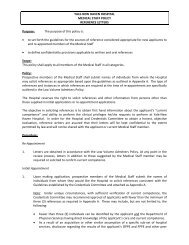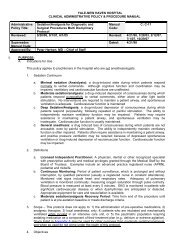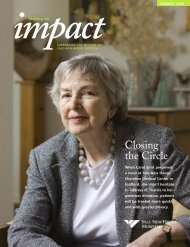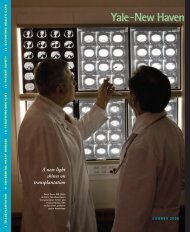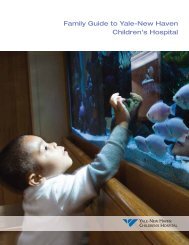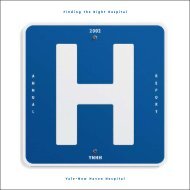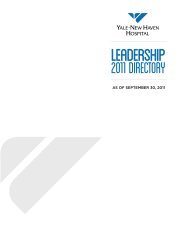Nursing Update 2009 - 2010 - Yale-New Haven Hospital
Nursing Update 2009 - 2010 - Yale-New Haven Hospital
Nursing Update 2009 - 2010 - Yale-New Haven Hospital
- TAGS
- nursing
- haven
- www.ynhh.org
Create successful ePaper yourself
Turn your PDF publications into a flip-book with our unique Google optimized e-Paper software.
Bedside reporting increases<br />
patient safety and<br />
satisfaction<br />
Before bedside reporting began last summer<br />
on General Medicine units 5-7 and 9-7, their<br />
data showed that a significant percentage of<br />
patient falls occurred during shift changes.<br />
“At change of shift, nurses gave report<br />
in a large conference room,” said Kathleen<br />
Kenyon, RN, director of nursing, Medicine.<br />
“Up to 16 staff could be talking about patient<br />
plans of care. It was not an optimal environment<br />
for sharing information or learning.<br />
“On our units, we have moved change<br />
of shift right to the patient’s bedside,”<br />
continues Kenyon. “Staff now roll their<br />
workstation on wheels into the patient’s<br />
room to do the handoff. We used<br />
evidence-based research to introduce a<br />
change that is improving both patient<br />
safety and patient satisfaction.”<br />
Rochelle Mikolinski, RN, patient<br />
service manager, General Medicine Unit<br />
(7-5), points to the additional benefits of<br />
the bedside hand-offs. “We increase our<br />
patients’ involvement in decisions that<br />
affect their care and help novice nurses<br />
develop critical thinking through a goalcentered<br />
report. Bedside reporting is also<br />
very efficient: it takes less time, so it has<br />
allowed us to reduce incidental overtime.”<br />
“By doing bedside reporting at changeof-shift,<br />
we include the patient in the process,<br />
and he or she has an increased sense<br />
of ownership in their own care because<br />
they are involved in information-sharing<br />
and decision-making,” said John Sward,<br />
RN, patient service manager, General<br />
Medicine Unit (9-7). “Nurses now start<br />
their shift with improved understanding<br />
of each patient’s status.”<br />
<strong>Yale</strong> Pediatric Advanced<br />
Care Team improves quality<br />
of life for patients<br />
Cindy Jayanetti finds that her pediatric<br />
patients most appreciate the smallest gestures<br />
– offering a drink of water or asking<br />
how school is going. Jayanetti, APRN,<br />
coordinates the <strong>Yale</strong> Pediatric Advanced<br />
Care Team (YPACT), which provides the<br />
extra support measures her chronically ill<br />
patients and their families need. Whether<br />
it’s scheduling a much-in-demand massage,<br />
a Reiki or aromatherapy session, or<br />
providing better communication within<br />
and among the patient’s interdisciplinary<br />
teams, Jayanetti works to improve the<br />
quality of life for her young patients. With<br />
the support she receives from collaborating<br />
nurses and physicians, she’s been<br />
able to increase the number of patients<br />
she cares for over the past year.<br />
“I see how patients improve when they’re<br />
able to relax, whether it’s because of a massage<br />
or having their questions answered,”<br />
she said. “It makes a real difference.”<br />
Palliative care helps<br />
adult patients<br />
Leslie Blatt, APRN, coordinator of palliative<br />
care, recalls a 59-year-old cervical<br />
cancer patient who had had a resection.<br />
For 15 years, she had done well until a<br />
fistula caused increasing pain and then<br />
hospitalization. While the patient was<br />
hospitalized, it became clear that her<br />
cancer had reoccurred and that she was<br />
nearing the end of her life.<br />
“Working with a team of physicians,<br />
nurses, a social worker and chaplain, we<br />
managed her physical and emotional pain<br />
which enabled her to be alert with her<br />
loved ones,” recalls Blatt. “She was able<br />
to say good-bye and also help ease their<br />
burden because she was able to make her<br />
own end-of-life arrangements. What was<br />
most valuable to this patient was having<br />
the ability to tell everyone in her life what<br />
they meant to her.”<br />
nurses lead chest pain<br />
center accreditation<br />
YNHH is the first and only Connecticut<br />
hospital to receive Cycle III accreditation<br />
from the Society of Chest Pain Centers<br />
(SCPC) as a Chest Pain Center with Percutaneous<br />
Coronary Intervention. Cycle III<br />
is the highest level of accreditation that<br />
the society gives.<br />
“Gaining this three-year accreditation<br />
is a major accomplishment that says<br />
volumes about the quality of care patients<br />
receive here at <strong>Yale</strong>-<strong>New</strong> <strong>Haven</strong>,” said<br />
Mariane Carna, RN, MSN, executive<br />
director, Heart and Vascular Services,<br />
who notes that YNHH is the largest<br />
provider of heart and vascular services in<br />
the state.<br />
Charlotte Hickey, RN, the clinical coordinator<br />
of our Women’s Heart Program,<br />
was responsible for organizing staff<br />
and meeting the SCPC’s deadlines. The<br />
rigorous accreditation process examined<br />
the hospital, its policies and processes,<br />
the competencies and training of the<br />
staff who care for cardiac patients, community<br />
education on heart disease, and<br />
performance measures for diagnosing<br />
and treating patients with acute coronary<br />
syndrome.<br />
“We are a designated chest pain center<br />
that provides the best in cardiac care to<br />
our patients,” said Hickey, who also does<br />
community outreach. “But we also work<br />
hard to keep people from developing<br />
cardiac disease in the first place.”<br />
A truly patient-, familycentered<br />
care experience<br />
Kelley Reddington, RNC-OB, admitted a<br />
patient at 34 weeks gestation, whose<br />
baby – with Down syndrome – had died in<br />
utero and was to be induced. The family<br />
also had an 8-year-old son, to whom they<br />
wanted to introduce – however, briefly –<br />
his sister. However, the unit’s visitor policy<br />
excludes children under the age of 12.<br />
“After conferring with the family, I<br />
knew their emotional needs were of the<br />
utmost importance,” explained Reddington.<br />
“By using a team approach, I was<br />
able to create a unique plan of care for this<br />
grieving family that would allow their son<br />
to visit.”<br />
As the mother was about to be discharged,<br />
Reddington visited the patient,<br />
who told her that she had gone “above and<br />
beyond” in her care for the entire family.<br />
“I just treated them the way I would want<br />
to be treated,” Reddington recalls. “They<br />
touched my life and made me realize I love<br />
being a YNHH nurse because I have the<br />
autonomy to change the standard of care<br />
to meet the needs of my patients.”<br />
Y A L e - n e w h A V e n h o s P I T A L 9


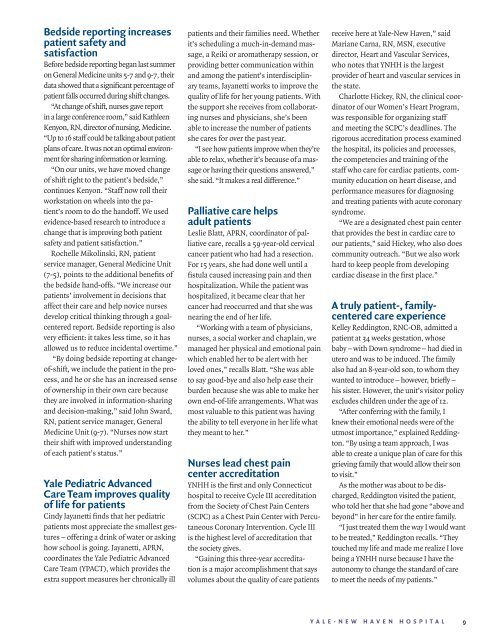
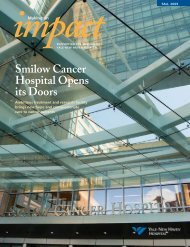
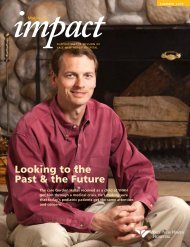

![Annual Report Donor Listings [pdf] - Yale-New Haven Hospital](https://img.yumpu.com/49673575/1/190x245/annual-report-donor-listings-pdf-yale-new-haven-hospital.jpg?quality=85)

